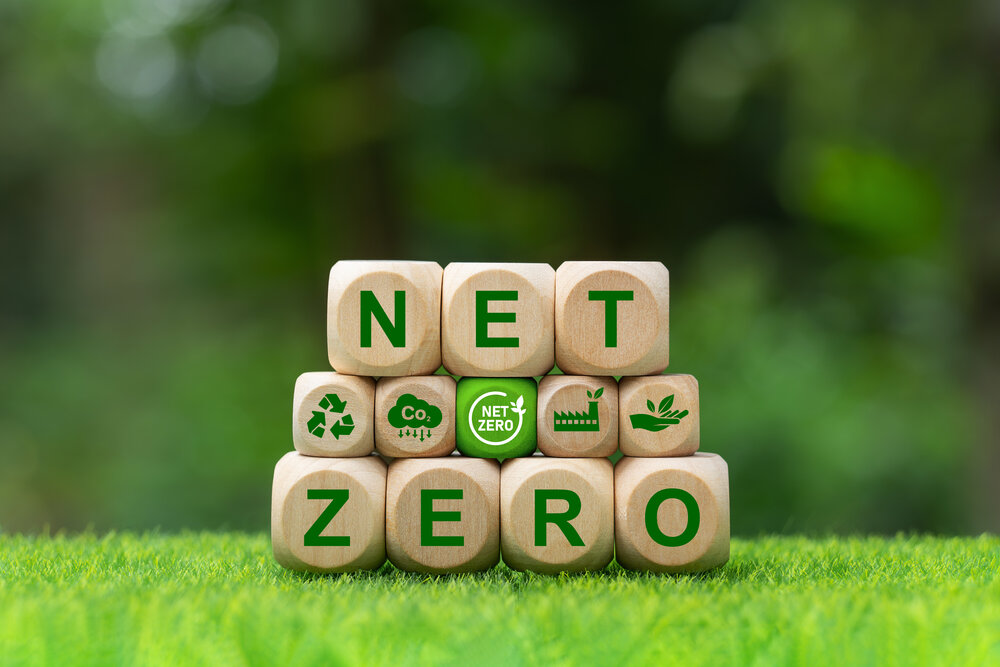As global warming accelerates and greenhouse gas emissions continue to rise, pressure mounts on governments, companies, and individuals to reach net zero. The European Union, alongside the United Nations, has set ambitious net zero targets to align with the 1.5°C pathway and curb global emissions.
From tracking progress with a net zero tracker to reducing carbon dioxide across all sectors, achieving a net zero target is now a global priority. Becoming carbon neutral is no longer optional, but essential for all countries. Our latest blog covers the 8 countries that have achieved carbon neutrality, with overviews of key inspiring efforts that have been made.
What Is Net-Zero Emissions?
When ‘net-zero emissions’ is achieved, it means that a company, country, person, product, building, or any system simply balances the amount of emissions it generates with the amount it removes from the atmosphere.
This doesn’t mean that it itself generates no emissions. Many types of emissions can’t be removed such as industrial activities or methane from agriculture.
These unavoidable emissions must be offset via carbon projects only after all other general emissions have been reduced where possible with carbon accounting strategies.
Achieving net zero can look different across a range of operations:
A company might invest in good Carbon Accounting software to measure their carbon footprint business-wide, implement reduction strategies where possible, and offset the remaining emissions with carbon removal projects to achieve net zero.
A person could use a free carbon calculator online, such as WWF’s, cut emissions from lifestyle changes like veganism or EVs, invest in trusted carbon projects, and achieve net zero when the footprint is fully balanced.
For a product, the company can conduct a thorough LCA (Life Cycle Assessment) to measure emissions, use sustainable materials in manufacturing, optimise supply chains, offset emissions cradle-to-grave, and then list as a net zero product.
For a building, companies can gauge its footprint by measuring operational and embodied carbon, power with renewables, optimise energy efficiency, offset construction and operational emissions, then announce net zero with recurring operational offsets.
Lastly, a country might set a national net-zero target for a realistic timeline, minimise the highest domestic emission sources, protect and expand its natural carbon sinks, and be considered net zero when its territorial emissions are fully offset.

Bhutan
Bhutan, landlocked between India and China in the Eastern Himalayas, is known for its dense forests, eco-tourism, and unparalleled happiness levels of the Bhutanese people.
Since the early 1960s, the country has largely relied on subsistence (non-commercial) farming (e.g. rice, maize, buckwheat) and hydropower. With a low population density and no industry of significant scale or heavy manufacturing, Bhutan has never been a major contributor of high emissions.
Their 2008 Constitution mandated at least 60% forest cover “for all time”, and they declared to stay carbon-neutral in 2009 “for all time” at COP15.
In 2015, Bhutan became fully carbon-negative, with their renewables and forests sequestering more carbon than emitted across all of its economic sectors.
Suriname
In northern South America, the country Suriname has a population of under 620,000, and is known for dense tropical rainforests making up over 90% of its land cover plus gold mining.
Forest preservation was not a strong priority nationally until deforestation began to rise due to mining and infrastructure expansion. In the early 2010s, environmental focus tightened.
They have engaged with REDD+ (Reducing Emissions from Deforestation and Forest Degradation) projects since 2013, which implement comprehensive methods to protect vulnerable forests like legal frameworks, monitoring, or community engagement.
Alongside an array of conservation measures, these meant Suriname could declare carbon-negative status in 2014.
Panama
Panama links North and South America, population 4.5 million people, and is known for its tropical biodiversity, plus a strategic shipping route.
Situated in the narrowest point of the Americas, the Panama Canal plays a key economic role; however, Panama’s main emissions sources have been from land-use change and domestic transport.
In the early 2000s, net zero shifts began, accelerated by the Paris Agreement, which kickstarted their joinment into REDD+, adopting sustainable transport, climate-smart agriculture, and promoting renewable energy.
These have helped it achieve a carbon-negative status.
Madagascar
Off the southeast coast of Africa, Madagascar is the fourth-largest island in the world. 90% of its wildlife is found nowhere else, such as chameleons, lemurs, and baobabs.
With low per-capita emissions due to a lack of industrialisation, the country is still one of Africa’s most vulnerable to climate change. Threats of droughts, cyclones, rising sea levels have sparked mass change in recent years, including REDD+, new policies in sustainable land use, and involvement in the carbon markets.
The nation’s high poverty levels have induced widespread slash-and-burn deforestation; however large-scale reforestation projects and mangrove restoration have helped restore emission levels.
In 2020 it was announced a temporary carbon sink, meaning Madagascar currently absorbs more CO₂ than it emits.
Gabon
In the central-west coast of Africa, Gabon boasts 88% forest cover, major oil revenues, and a low population of 2.4 million.
Pre-net-zero efforts, their economy relied on oil and logging, with relatively low emissions until the 90s.
In 1996, Gabon brought out their first forest policy, then a sustainable logging law in 2001. Climate efforts developed and were accelerated post Paris Agreement, seeing REDD+ participation from 2015.
Gabon became informally carbon-negative later in 2016, reinforced in 2021 by its first results-based carbon payment via CAFI (Central African Forest Initiative) of $ 17 million for verifiable carbon forestry savings.
Guyana
In northeastern South America, Guyana has a population of around 800,000 and is known for its Congo-like rainforests.
With around 90% forest cover and minimal industries, Guyana has always boasted very low emissions. In 2009, Guyana began offshore oil exploration, but it wasn’t until 2015 that major reserves were confirmed now estimated at up to 11 billion barrels, valued at over £500 billion.
Upon this discovery, they faced a dilemma of exploiting the oil to immensely boost their economy, or preserving their forests and developing a green economy. They chose the latter, sidelining the reserves for a decade, investing significantly in REDD+.
By 2019 they began oil production, but with trusted forest protection schemes in place, meaning their immense carbon sinks have maintained the carbon negative status since 2016.
Comoros
Comoros is a volcanic archipelago in the Indian Ocean with a population of around 800,000, known for subsistence fishing and farming·(to feed their family or community rather than for commercial reasons).
With very low emissions per capita and low industrialisation, the country reported being a net carbon sink in 2015 from its dense forest cover of around 73%.
Their carbon negative status happened by circumstance more than effort, barely any fossil fuel use, and minimal transport due to low demand or geography.
Niue
Northeast of New Zealand, Niue is one of the world’s smallest countries, a single-island nation in the South Pacific. Populating around 1,900 Niuean people, the nation is known for coral limestone cliffs and marine biodiversity.
With near-zero industrial activity, the country has largely relied on imported fossil fuels for its very low total energy consumption.
Net zero efforts were kick-started following the Paris Agreement, setting a target in 2015 to hit 80% of renewable electricity by 2025. They’ve jumped from 2% to 38% thanks to solar advancements, and have major infrastructure underway with the aim of hitting 80% by the end of the year.
They have been carbon negative since 2019, with high levels of land carbon absorbed.
Key Characteristics of Net-Zero Nations
Out of the 8 net-zero countries, many share some key characteristics that contribute to their carbon neutrality:
Small islands like Comoros and low-lying coastal areas like Guyana are incredibly vulnerable to climate change, incentivising climate action on a mass scale.
Following various disasters such as hurricanes or sea-level rise events, changes are hastily adapted such as new renewable energy infrastructure. This lends well towards carbon sequestration and reduction efforts.
The countries’ abundance of carbon sinks between forests, wetlands, or grasslands, emit heaps of carbon every year. Many nations have subsequently protected these by implementing conservation policies, and some expanded through reforestation and restoration.
As the countries tend to be developing nations, they have much lower industrial activity than developed countries. Without emissions from major factories and large-scale fossil fuel consumption, their overall carbon footprint is drastically less than that of a Western country.
The 8 countries’ populations can be as low as around 1,900 (Niue), compared to somewhere like the UK with nearly 70 million people. Less population means less urbanisation, less industrialisation, and more rural ways of living, making the countries’ emissions per capita much lower.
Additionally, many of these countries rely heavily on territorial emissions accounting, meaning they count only emissions produced within their borders and often exclude emissions embedded in imported goods or international travel. This can understate their true carbon footprint compared to nations with globalised economies.
Furthermore, these countries often have limited heavy transport and aviation sectors, which are some of the hardest to decarbonise and contribute significantly to emissions in larger, developed nations.
Lessons for the Rest of the World
From looking at the 8 net-zero countries, there are many lessons to be learnt and followed by the rest of the world.
If the world’s largest emitters protected their carbon sinks the way that Bhutan does legally safeguarding vast forest areas and committing to reforestation, our global carbon levels would be significantly lower.
Bhutan, for instance, enshrined in its constitution that at least 60% of its land will remain forested. If major economies followed that logic, we’d have a far stronger natural buffer against climate change.
Niue’s switch to 100% renewable energy is immense, relying entirely on solar power. If an energy-hungry country like South Africa adopted renewables at scale, energy security would be improved significantly.
Guyana’s REDD+ forest conservation incentives have protected up to 87% of its forested land through avoiding deforestation and generating carbon credits. While the world is slowly adopting carbon credit mechanisms, operating at this scale is a fantastic blueprint for high-forest, low-deforestation countries like the Democratic Republic of Congo or Malaysia.
In the Maldives, large-scale investments have been made into sea walls, flood defences and other climate-resilient infrastructure. As a result, the islands have been better protected against rising sea levels and extreme weather, safeguarding communities and vital ecosystems. Many low-lying countries like the Netherlands or Bangladesh bear the same vulnerability and would benefit from making similar investments.
Since the early 2000s, Panama has focused significantly on sustainable land use , reducing deforestation and promoting regenerative agriculture through targeted national policies. This shows how well-designed governmental incentives can fast-track environmental progress.
Countries like the UK have begun to follow this model with schemes like Biodiversity Net Gain, which mandate habitat re-creation for new developments. But while these efforts are promising, they still fall short of the scale and ambition seen in Panama, highlighting how much further major economies must go to catch up.
More Information
https://www.ccacoalition.org/partners/panama
https://worldpopulationreview.com/country-rankings/carbon-negative-countries
https://sustainableearthreviews.biomedcentral.com/articles/10.1186/s42055-023-00053-8
https://www.gvi.co.uk/blog/bhutan-carbon-negative-country-world
https://climatepromise.undp.org/what-we-do/where-we-work/suriname
https://carboncredits.com/suriname-takes-the-lead-in-selling-carbon-credits-under-paris-agreement

